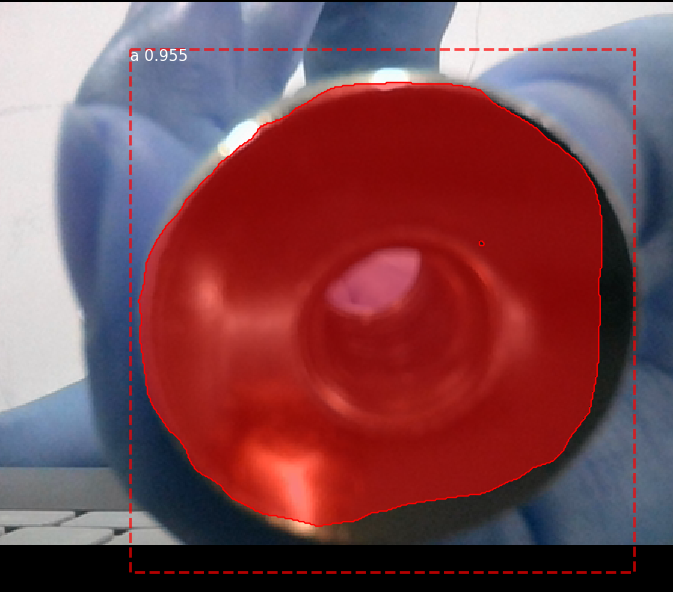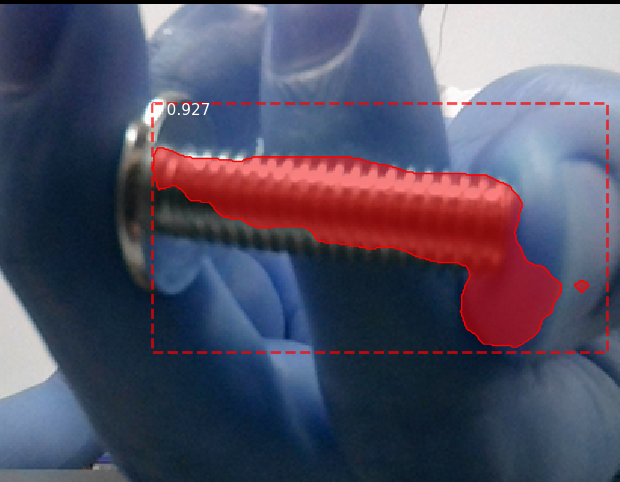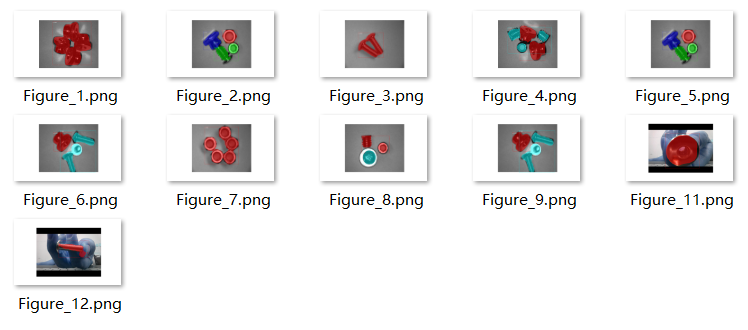mask_rcnn训练自己的数据集
1、首先从官方下载mask_rcnn源码https://github.com/matterport/Mask_RCNN
2、当制作自己的数据集的时候,图片的大小一定要记得修改,长宽都要修改为修改为2的6次方的倍数,不然训练的时候会报错,来看源代码:

2、首先将demo.ipynb转换成demo.py,这里我顺便更改为适用于我自己数据集:
import os
import sys
import random
import math
import numpy as np
import skimage.io
import matplotlib
import matplotlib.pyplot as plt
import cv2
import time
from mrcnn.config import Config
from datetime import datetime
# Root directory of the project
ROOT_DIR = os.path.abspath("../") # Import Mask RCNN
sys.path.append(ROOT_DIR) # To find local version of the library
from mrcnn import utils
import mrcnn.model as modellib
from mrcnn import visualize
# Import COCO config
sys.path.append(os.path.join(ROOT_DIR, "samples/coco/")) # To find local version
import coco # Directory to save logs and trained model
MODEL_DIR = os.path.join(ROOT_DIR, "logs/shapes20190425T0816") # Local path to trained weights file
COCO_MODEL_PATH = os.path.join(MODEL_DIR ,"mask_rcnn_shapes_0030.h5")
# Download COCO trained weights from Releases if needed
if not os.path.exists(COCO_MODEL_PATH):
utils.download_trained_weights(COCO_MODEL_PATH)
print("cuiwei***********************") # Directory of images to run detection on
IMAGE_DIR = os.path.join(ROOT_DIR, "images")
class ShapesConfig(Config):
"""Configuration for training on the toy shapes dataset.
Derives from the base Config class and overrides values specific
to the toy shapes dataset.
"""
# Give the configuration a recognizable name
NAME = "shapes" # Train on 1 GPU and 8 images per GPU. We can put multiple images on each
# GPU because the images are small. Batch size is 8 (GPUs * images/GPU).
GPU_COUNT = 1
IMAGES_PER_GPU = 1 # Number of classes (including background)
NUM_CLASSES = 1 + 4 # background + 3 shapes # Use small images for faster training. Set the limits of the small side
# the large side, and that determines the image shape.
IMAGE_MIN_DIM = 320
IMAGE_MAX_DIM = 384 # Use smaller anchors because our image and objects are small
RPN_ANCHOR_SCALES = (8 * 6, 16 * 6, 32 * 6, 64 * 6, 128 * 6) # anchor side in pixels # Reduce training ROIs per image because the images are small and have
# few objects. Aim to allow ROI sampling to pick 33% positive ROIs.
TRAIN_ROIS_PER_IMAGE =100 # Use a small epoch since the data is simple
STEPS_PER_EPOCH = 100 # use small validation steps since the epoch is small
VALIDATION_STEPS = 50 class InferenceConfig(ShapesConfig):
# Set batch size to 1 since we'll be running inference on
# one image at a time. Batch size = GPU_COUNT * IMAGES_PER_GPU
GPU_COUNT = 1
IMAGES_PER_GPU = 1 config = InferenceConfig()
config.display() # Create model object in inference mode.
model = modellib.MaskRCNN(mode="inference", model_dir=MODEL_DIR, config=config) # Load weights trained on MS-COCO
model.load_weights(COCO_MODEL_PATH, by_name=True) # COCO Class names
# Index of the class in the list is its ID. For example, to get ID of
# the teddy bear class, use: class_names.index('teddy bear')
class_names = ['BG', 'a','b','c','e']
# Load a random image from the images folder
#file_names = next(os.walk(IMAGE_DIR))[2]
#image = skimage.io.imread(os.path.join(IMAGE_DIR, random.choice(file_names)))
cap = cv2.VideoCapture(0) while(1):
# get a frame
ret, frame = cap.read()
# show a frame
start =time.clock()
results = model.detect([frame], verbose=1)
r = results[0]
#cv2.imshow("capture", frame)
visualize.display_instances(frame, r['rois'], r['masks'], r['class_ids'],
class_names, r['scores'])
end = time.clock()
print(end-start)
if cv2.waitKey(1) & 0xFF == ord('q'):
break cap.release()
cv2.destroyAllWindows() #image= cv2.imread("C:\\Users\\18301\\Desktop\\Mask_RCNN-master\\images\\9.jpg")
## Run detection
#
#results = model.detect([image], verbose=1)
#
#print(end-start)
## Visualize results
#r = results[0]
#visualize.display_instances(image, r['rois'], r['masks'], r['class_ids'],
# class_names, r['scores'])
以上这段代码可以调用摄像头拍摄图片进行目标识别。


以下为训练文件:
# -*- coding: utf-8 -*- import os
import sys
import random
import math
import re
import time
import numpy as np
import cv2
import matplotlib
import matplotlib.pyplot as plt
import tensorflow as tf
from mrcnn.config import Config
#import utils
from mrcnn import model as modellib,utils
from mrcnn import visualize
import yaml
from mrcnn.model import log
from PIL import Image #os.environ["CUDA_VISIBLE_DEVICES"] = "0"
# Root directory of the project
ROOT_DIR = os.getcwd() #ROOT_DIR = os.path.abspath("../")
# Directory to save logs and trained model
MODEL_DIR = os.path.join(ROOT_DIR, "logs") iter_num=0 # Local path to trained weights file
COCO_MODEL_PATH = os.path.join(ROOT_DIR, "mask_rcnn_coco.h5")
# Download COCO trained weights from Releases if needed
if not os.path.exists(COCO_MODEL_PATH):
utils.download_trained_weights(COCO_MODEL_PATH) class ShapesConfig(Config):
"""Configuration for training on the toy shapes dataset.
Derives from the base Config class and overrides values specific
to the toy shapes dataset.
"""
# Give the configuration a recognizable name
NAME = "shapes" # Train on 1 GPU and 8 images per GPU. We can put multiple images on each
# GPU because the images are small. Batch size is 8 (GPUs * images/GPU).
GPU_COUNT = 1
IMAGES_PER_GPU = 1 # Number of classes (including background)
NUM_CLASSES = 1 + 4 # background + 3 shapes # Use small images for faster training. Set the limits of the small side
# the large side, and that determines the image shape.
IMAGE_MIN_DIM = 320
IMAGE_MAX_DIM = 384 # Use smaller anchors because our image and objects are small
RPN_ANCHOR_SCALES = (8 * 6, 16 * 6, 32 * 6, 64 * 6, 128 * 6) # anchor side in pixels # Reduce training ROIs per image because the images are small and have
# few objects. Aim to allow ROI sampling to pick 33% positive ROIs.
TRAIN_ROIS_PER_IMAGE = 100 # Use a small epoch since the data is simple
STEPS_PER_EPOCH = 100 # use small validation steps since the epoch is small
VALIDATION_STEPS = 50 config = ShapesConfig()
config.display() class DrugDataset(utils.Dataset):
# 得到该图中有多少个实例(物体)
def get_obj_index(self, image):
n = np.max(image)
return n # 解析labelme中得到的yaml文件,从而得到mask每一层对应的实例标签
def from_yaml_get_class(self, image_id):
info = self.image_info[image_id]
with open(info['yaml_path']) as f:
temp = yaml.load(f.read())
labels = temp['label_names']
del labels[0]
return labels # 重新写draw_mask
def draw_mask(self, num_obj, mask, image,image_id):
#print("draw_mask-->",image_id)
#print("self.image_info",self.image_info)
info = self.image_info[image_id]
#print("info-->",info)
#print("info[width]----->",info['width'],"-info[height]--->",info['height'])
for index in range(num_obj):
for i in range(info['width']):
for j in range(info['height']):
#print("image_id-->",image_id,"-i--->",i,"-j--->",j)
#print("info[width]----->",info['width'],"-info[height]--->",info['height'])
at_pixel = image.getpixel((i, j))
if at_pixel == index + 1:
mask[j, i, index] = 1
return mask # 重新写load_shapes,里面包含自己的自己的类别
# 并在self.image_info信息中添加了path、mask_path 、yaml_path
# yaml_pathdataset_root_path = "/tongue_dateset/"
# img_floder = dataset_root_path + "rgb"
# mask_floder = dataset_root_path + "mask"
# dataset_root_path = "/tongue_dateset/"
def load_shapes(self, count, img_floder, mask_floder, imglist, dataset_root_path):
"""Generate the requested number of synthetic images.
count: number of images to generate.
height, width: the size of the generated images.
"""
# Add classes
self.add_class("shapes", 1, "a")
self.add_class("shapes", 2, "b")
self.add_class("shapes", 3, "c")
self.add_class("shapes", 4, "e")
for i in range(count):
# 获取图片宽和高 filestr = imglist[i].split(".")[0]
#print(imglist[i],"-->",cv_img.shape[1],"--->",cv_img.shape[0])
#print("id-->", i, " imglist[", i, "]-->", imglist[i],"filestr-->",filestr)
# filestr = filestr.split("_")[1]
mask_path = mask_floder + "/" + filestr + ".png"
yaml_path = dataset_root_path + "labelme_json/" + filestr + "_json/info.yaml"
print(dataset_root_path + "labelme_json/" + filestr + "_json/img.png")
cv_img = cv2.imread(dataset_root_path + "labelme_json/" + filestr + "_json/img.png") self.add_image("shapes", image_id=i, path=img_floder + "/" + imglist[i],
width=cv_img.shape[1], height=cv_img.shape[0], mask_path=mask_path, yaml_path=yaml_path) # 重写load_mask
def load_mask(self, image_id):
"""Generate instance masks for shapes of the given image ID.
"""
global iter_num
print("image_id",image_id)
info = self.image_info[image_id]
count = 1 # number of object
img = Image.open(info['mask_path'])
num_obj = self.get_obj_index(img)
mask = np.zeros([info['height'], info['width'], num_obj], dtype=np.uint8)
mask = self.draw_mask(num_obj, mask, img,image_id)
occlusion = np.logical_not(mask[:, :, -1]).astype(np.uint8)
for i in range(count - 2, -1, -1):
mask[:, :, i] = mask[:, :, i] * occlusion occlusion = np.logical_and(occlusion, np.logical_not(mask[:, :, i]))
labels = []
labels = self.from_yaml_get_class(image_id)
labels_form = []
for i in range(len(labels)):
if labels[i].find("a") != -1:
labels_form.append("a")
elif labels[i].find("b") != -1:
labels_form.append("b")
elif labels[i].find("c") != -1:
labels_form.append("c")
elif labels[i].find("e") != -1:
labels_form.append("e")
class_ids = np.array([self.class_names.index(s) for s in labels_form])
return mask, class_ids.astype(np.int32) def get_ax(rows=1, cols=1, size=8):
"""Return a Matplotlib Axes array to be used in
all visualizations in the notebook. Provide a
central point to control graph sizes. Change the default size attribute to control the size
of rendered images
"""
_, ax = plt.subplots(rows, cols, figsize=(size * cols, size * rows))
return ax #基础设置
dataset_root_path="train_data/"
img_floder = dataset_root_path + "pic"
mask_floder = dataset_root_path + "cv2_mask"
#yaml_floder = dataset_root_path
imglist = os.listdir(img_floder)
count = len(imglist) #train与val数据集准备
dataset_train = DrugDataset()
dataset_train.load_shapes(count, img_floder, mask_floder, imglist,dataset_root_path)
dataset_train.prepare() #print("dataset_train-->",dataset_train._image_ids) dataset_val = DrugDataset()
dataset_val.load_shapes(7, img_floder, mask_floder, imglist,dataset_root_path)
dataset_val.prepare() #print("dataset_val-->",dataset_val._image_ids) # Load and display random samples
#image_ids = np.random.choice(dataset_train.image_ids, 4)
#for image_id in image_ids:
# image = dataset_train.load_image(image_id)
# mask, class_ids = dataset_train.load_mask(image_id)
# visualize.display_top_masks(image, mask, class_ids, dataset_train.class_names) # Create model in training mode
model = modellib.MaskRCNN(mode="training", config=config,
model_dir=MODEL_DIR) # Which weights to start with?
init_with = "coco" # imagenet, coco, or last if init_with == "imagenet":
model.load_weights(model.get_imagenet_weights(), by_name=True)
elif init_with == "coco":
# Load weights trained on MS COCO, but skip layers that
# are different due to the different number of classes
# See README for instructions to download the COCO weights
model.load_weights(COCO_MODEL_PATH, by_name=True,
exclude=["mrcnn_class_logits", "mrcnn_bbox_fc",
"mrcnn_bbox", "mrcnn_mask"])
elif init_with == "last":
# Load the last model you trained and continue training
model.load_weights(model.find_last()[1], by_name=True) # Train the head branches
# Passing layers="heads" freezes all layers except the head
# layers. You can also pass a regular expression to select
# which layers to train by name pattern.
model.train(dataset_train, dataset_val,
learning_rate=config.LEARNING_RATE,
epochs=10,
layers='heads') # Fine tune all layers
# Passing layers="all" trains all layers. You can also
# pass a regular expression to select which layers to
# train by name pattern.
model.train(dataset_train, dataset_val,
learning_rate=config.LEARNING_RATE / 10,
epochs=30,
layers="all")
以下为测试代码:
# -*- coding: utf-8 -*- import os
import sys
import random
import math
import numpy as np
import skimage.io
import matplotlib
import matplotlib.pyplot as plt
import cv2
import time
from mrcnn.config import Config
from datetime import datetime
# Root directory of the project
ROOT_DIR = os.getcwd() # Import Mask RCNN
sys.path.append(ROOT_DIR) # To find local version of the library
from mrcnn import utils
import mrcnn.model as modellib
from mrcnn import visualize
# Import COCO config
sys.path.append(os.path.join(ROOT_DIR, "samples/coco/")) # To find local version
from samples.coco import coco # Directory to save logs and trained model
MODEL_DIR = os.path.join(ROOT_DIR, "logs/shapes20190425T0816/") # Local path to trained weights file
COCO_MODEL_PATH = os.path.join(MODEL_DIR ,"mask_rcnn_shapes_0030.h5")
# Download COCO trained weights from Releases if needed
if not os.path.exists(COCO_MODEL_PATH):
utils.download_trained_weights(COCO_MODEL_PATH)
print("wancheng***********************") # Directory of images to run detection on
IMAGE_DIR = os.path.join(ROOT_DIR, "images") class ShapesConfig(Config):
"""Configuration for training on the toy shapes dataset.
Derives from the base Config class and overrides values specific
to the toy shapes dataset.
"""
# Give the configuration a recognizable name
NAME = "shapes" # Train on 1 GPU and 8 images per GPU. We can put multiple images on each
# GPU because the images are small. Batch size is 8 (GPUs * images/GPU).
GPU_COUNT = 1
IMAGES_PER_GPU = 1 # Number of classes (including background)
NUM_CLASSES = 1 + 4 # background + 3 shapes # Use small images for faster training. Set the limits of the small side
# the large side, and that determines the image shape.
IMAGE_MIN_DIM = 320
IMAGE_MAX_DIM = 384 # Use smaller anchors because our image and objects are small
RPN_ANCHOR_SCALES = (8 * 6, 16 * 6, 32 * 6, 64 * 6, 128 * 6) # anchor side in pixels # Reduce training ROIs per image because the images are small and have
# few objects. Aim to allow ROI sampling to pick 33% positive ROIs.
TRAIN_ROIS_PER_IMAGE =100 # Use a small epoch since the data is simple
STEPS_PER_EPOCH = 100 # use small validation steps since the epoch is small
VALIDATION_STEPS = 50 #import train_tongue
#class InferenceConfig(coco.CocoConfig):
class InferenceConfig(ShapesConfig):
# Set batch size to 1 since we'll be running inference on
# one image at a time. Batch size = GPU_COUNT * IMAGES_PER_GPU
GPU_COUNT = 1
IMAGES_PER_GPU = 1 config = InferenceConfig() model = modellib.MaskRCNN(mode="inference", model_dir=MODEL_DIR, config=config) # Create model object in inference mode.
model = modellib.MaskRCNN(mode="inference", model_dir=MODEL_DIR, config=config) # Load weights trained on MS-COCO
model.load_weights(COCO_MODEL_PATH, by_name=True) # COCO Class names
# Index of the class in the list is its ID. For example, to get ID of
# the teddy bear class, use: class_names.index('teddy bear')
class_names = ['BG', 'a','b','c','e']
# Load a random image from the images folder
file_names = next(os.walk(IMAGE_DIR))[2]
image = skimage.io.imread(os.path.join(IMAGE_DIR, random.choice(file_names))) a=datetime.now()
# Run detection
results = model.detect([image], verbose=1)
b=datetime.now()
# Visualize results
print("shijian",(b-a).seconds)
r = results[0]
visualize.display_instances(image, r['rois'], r['masks'], r['class_ids'],
class_names, r['scores'])
# Load a random image from the images folder
#file_names = next(os.walk(IMAGE_DIR))[2]
#image = skimage.io.imread(os.path.join(IMAGE_DIR, random.choice(file_names)))
#cap = cv2.VideoCapture(0)
#
#while(1):
# # get a frame
# ret, frame = cap.read()
# # show a frame
# start =time.clock()
# results = model.detect([frame], verbose=1)
# r = results[0]
# #cv2.imshow("capture", frame)
# visualize.display_instances(frame, r['rois'], r['masks'], r['class_ids'],
# class_names, r['scores'])
# end = time.clock()
# print(end-start)
# if cv2.waitKey(1) & 0xFF == ord('q'):
# break
#
#cap.release()
#cv2.destroyAllWindows() #image= cv2.imread("C:\\Users\\18301\\Desktop\\Mask_RCNN-master\\images\\9.jpg")
## Run detection
#
#results = model.detect([image], verbose=1)
#
#print(end-start)
## Visualize results
#r = results[0]
#visualize.display_instances(image, r['rois'], r['masks'], r['class_ids'],
# class_names, r['scores']) ## Root directory of the project
#ROOT_DIR = os.getcwd()
#
## Directory to save logs and trained model
#MODEL_DIR = os.path.join(ROOT_DIR, "logs/shapes20180713T1554")
#
## Local path to trained weights file
#COCO_MODEL_PATH = os.path.join(ROOT_DIR, "mask_rcnn_coco.h5")
## Download COCO trained weights from Releases if needed
#if not os.path.exists(COCO_MODEL_PATH):
# utils.download_trained_weights(COCO_MODEL_PATH)
#
## Directory of images to run detection on
#IMAGE_DIR = os.path.join(ROOT_DIR, "images")
#
#class ShapesConfig(Config):
# """Configuration for training on the toy shapes dataset.
# Derives from the base Config class and overrides values specific
# to the toy shapes dataset.
# """
# # Give the configuration a recognizable name
# NAME = "shapes"
#
# # Train on 1 GPU and 8 images per GPU. We can put multiple images on each
# # GPU because the images are small. Batch size is 8 (GPUs * images/GPU).
# GPU_COUNT = 1
# IMAGES_PER_GPU = 1
#
# # Number of classes (including background)
# NUM_CLASSES = 1 + 1 # background + 3 shapes
#
# # Use small images for faster training. Set the limits of the small side
# # the large side, and that determines the image shape.
# IMAGE_MIN_DIM = 320
# IMAGE_MAX_DIM = 384
#
# # Use smaller anchors because our image and objects are small
# RPN_ANCHOR_SCALES = (8 * 6, 16 * 6, 32 * 6, 64 * 6, 128 * 6) # anchor side in pixels
#
# # Reduce training ROIs per image because the images are small and have
# # few objects. Aim to allow ROI sampling to pick 33% positive ROIs.
# TRAIN_ROIS_PER_IMAGE =100
#
# # Use a small epoch since the data is simple
# STEPS_PER_EPOCH = 100
#
# # use small validation steps since the epoch is small
# VALIDATION_STEPS = 50
#
##import train_tongue
##class InferenceConfig(coco.CocoConfig):
#class InferenceConfig(ShapesConfig):
# # Set batch size to 1 since we'll be running inference on
# # one image at a time. Batch size = GPU_COUNT * IMAGES_PER_GPU
# GPU_COUNT = 1
# IMAGES_PER_GPU = 1
#
#config = InferenceConfig()
#
#model = modellib.MaskRCNN(mode="inference", model_dir=MODEL_DIR, config=config)
#
## Load weights trained on MS-COCO
## model.load_weights(COCO_MODEL_PATH, by_name=True)
#model_path = model.find_last()[0]
#
## Load trained weights (fill in path to trained weights here)
#assert model_path != "", "Provide path to trained weights"
#print("Loading weights from ", model_path)
#model.load_weights(model_path, by_name=True)
#
#class_names = ['BG', 'tank']
#
## Load a random image from the images folder
#file_names = next(os.walk(IMAGE_DIR))[2]
#image = skimage.io.imread(os.path.join(IMAGE_DIR, random.choice(file_names)))
#
## Run detection
#results = model.detect([image], verbose=1)
#
## Visualize results
#r = results[0]
#visualize.display_instances(image, r['rois'], r['masks'], r['class_ids'],
# class_names, r['scores'])
修改代码中的路径及数据集即可正常训练出自己的数据集

mask_rcnn训练自己的数据集的更多相关文章
- 【Tensorflow系列】使用Inception_resnet_v2训练自己的数据集并用Tensorboard监控
[写在前面] 用Tensorflow(TF)已实现好的卷积神经网络(CNN)模型来训练自己的数据集,验证目前较成熟模型在不同数据集上的准确度,如Inception_V3, VGG16,Inceptio ...
- 目标检测算法SSD之训练自己的数据集
目标检测算法SSD之训练自己的数据集 prerequesties 预备知识/前提条件 下载和配置了最新SSD代码 git clone https://github.com/weiliu89/caffe ...
- 可变卷积Deforable ConvNet 迁移训练自己的数据集 MXNet框架 GPU版
[引言] 最近在用可变卷积的rfcn 模型迁移训练自己的数据集, MSRA官方使用的MXNet框架 环境搭建及配置:http://www.cnblogs.com/andre-ma/p/8867031. ...
- caffe训练自己的数据集
默认caffe已经编译好了,并且编译好了pycaffe 1 数据准备 首先准备训练和测试数据集,这里准备两类数据,分别放在文件夹0和文件夹1中(之所以使用0和1命名数据类别,是因为方便标注数据类别,直 ...
- 使用yolo3模型训练自己的数据集
使用yolo3模型训练自己的数据集 本项目地址:https://github.com/Cw-zero/Retrain-yolo3 一.运行环境 1. Ubuntu16.04. 2. TensorFlo ...
- Win10中用yolov3训练自己的数据集全过程(VS、CUDA、CUDNN、OpenCV配置,训练和测试)
在Windows系统的Linux系统中用yolo训练自己的数据集的配置差异很大,今天总结在win10中配置yolo并进行训练和测试的全过程. 提纲: 1.下载适用于Windows的darknet 2. ...
- TensorFlow学习笔记——LeNet-5(训练自己的数据集)
在之前的TensorFlow学习笔记——图像识别与卷积神经网络(链接:请点击我)中了解了一下经典的卷积神经网络模型LeNet模型.那其实之前学习了别人的代码实现了LeNet网络对MNIST数据集的训练 ...
- YOLO训练自己的数据集的一些心得
YOLO训练自己的数据集 YOLO-darknet训练自己的数据 [Darknet][yolo v2]训练自己数据集的一些心得----VOC格式 YOLO模型训练可视化训练过程中的中间参数 项目开源代 ...
- YOLO V3训练自己的数据集
数据的输入几乎和Faster rcnn一样,标签格式xml是一样的. 相比Faster rcnn,数据多了一步处理,通过voc_annotation.py将图片路径和bbox+class存储在txt下 ...
随机推荐
- 组装一台PRUSA I3打印机
闲来无事,又搞了台机.这样下去顶不住了.草. 还是咸鱼购买,但是这台收到的时候比我以前任何一台都要散,几乎重新装了一台. 此处省略收到货时候的零件图,省略装机图. 不得不提的是,原机用的山寨melzi ...
- 剑指offer(65)矩阵中的路径
题目描述 请设计一个函数,用来判断在一个矩阵中是否存在一条包含某字符串所有字符的路径.路径可以从矩阵中的任意一个格子开始,每一步可以在矩阵中向左,向右,向上,向下移动一个格子.如果一条路径经过了矩阵中 ...
- Bootstrap3基础 下载bootstrap3压缩包和相应的jQuery文件
内容 参数 OS Windows 10 x64 browser Firefox 65.0.2 framework Bootstrap 3.3.7 editor ...
- 20175312 2018-2019-2 实验一《Java开发环境的熟悉》实验报告
20175312 2018-2019-2 实验一<Java开发环境的熟悉>实验报告 实验内容 1.使用JDK编译.运行简单的Java程序: 2.使用Eclipse 编辑.编译.运行.调试J ...
- [MySQL] timestamp和datetime的区别
建表语句如下: create table strong_passwd_whitelist( id int unsigned not null auto_increment, email_id int ...
- async/await处理异步
async函数返回一个Promise对象,可以使用then方法添加回调函数.当函数执行的时候,一旦遇到await就会先返回,等到异步操作完成,再接着执行函数体内后面的语句. 看代码: 指定多少毫秒后输 ...
- newnewFoogetName高级面试题
- vim 复制粘贴
首先进入块模式 Ctrl+ v 使用按键j/k/h/l进行选中多列 使用按键y进行复制 在insert模式下:使用按键p进行粘贴
- Unity---在Hierarchy视图中将选中的对象的层级目录复制到剪切板
using UnityEditor; using UnityEngine; public class ObjPathCopyTool : ScriptableObject { [MenuItem(&q ...
- JS-getHours()方法
var time=new Date().getHours(); 获取当前系统时间的小时值,eg:若当前系统时间为2019.4.25 10:52 则返回10
